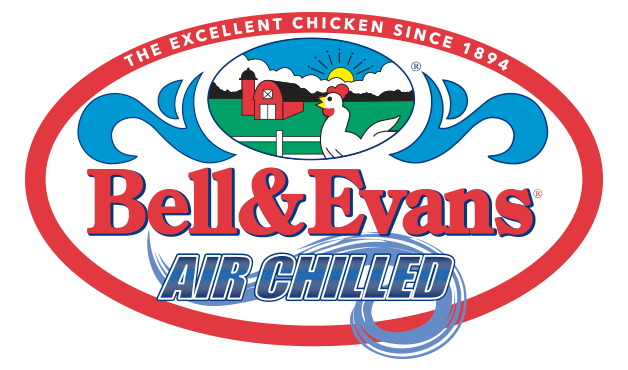Fredericksburg, Pennsylvania (November 27, 2017) – Bell & Evans is a family-owned company in Fredericksburg, PA, and pioneer of premium, natural and organic chicken. 100% of our chickens will be transitioned to our new breed, Das Klassenbester, by the end of 2018. The new breed is focused on higher-welfare and slower growing, resulting in more flavorful chicken. Bell & Evans will be the first U.S. chicken producer to fully convert to a higher-welfare, slower-growing chicken.
“We expect to invest more than $75 million in the new breed during the first five years, an investment I can’t see commodity producers making,” said Bell & Evans Owner and Visionary Scott Sechler. “We don’t raise commodity chickens. Every single chicken we process passes through our organic-certified Hatchery, never receives an antibiotic – even while in the egg – and have the same genetics, taking away all guesswork for our customers. We’re pretty proud to say that 100% of our products will come from a higher-welfare, better-quality breed.”
For decades, small and large chicken producers alike have had the same access to a limited menu of breed options as offered by a small number of breeding companies. Today, three primary breeders monopolize the broiler breeder industry and one of them is owned by Tyson Foods, the largest producer of broiler chicken in the U.S. Through the decades, profit-driven commodity producers have requested faster-growing, bigger and cheaper-to-raise chickens. These selective breeding demands have caused skeletal, cardiovascular and muscular issues in chickens because the birds grow faster than their bodies can handle. Chickens spend too much time lying on their breasts rather than moving around, which negatively affects their overall health and directly correlates to the poor quality issues, like white striping and tough, woody breasts, found in most poultry products today. Bell & Evans has experienced some quality issues related to the breed despite having the highest animal welfare standards in the industry and growing its chickens to a smaller live weight.
In 2015, Sechler pursued options for a better-quality breed of chickens by working with European breeders. A specialty female breed was selected for its slow growth and high meat yield, and a male breed was chosen for its excellent meat yield, fertility and livability rates. The new breed of offspring was named “Das Klassenbester” for its European descent and premium, best-in-class genetics.
“This is a big deal,” said Sechler. “So far, our testing has netted healthy, hardy chickens that result in a great-tasting, high-quality product with lots of flavor. No white striping or woody breasts were detected. We’re really excited to fully convert to the Klassenbester.”
The new breeds look different too. The Klassenbester broilers are mostly white feathered with some sporadic color variations. The variation coming from the female parent has rich reddish-brown feathers while the male parents are slightly larger than the females and have bright white feathers.
The first female pullets were placed into Bell & Evans’ pullet houses in May 2017. By the end of 2018, 100% of Bell & Evans’ chickens will be fully converted to the new breed. Bell & Evans already grows its chickens to a smaller size than most producers, averaging a live weight of only 5.6 lbs over 41 days. The new breed will average the same live weight, but will grow slower over 47 to 50 days, extending the growth cycle upwards of 15% and reducing unnecessary stress on their bodies, resulting in better overall health.
This investment in a higher-welfare, slower-growing breed will cost Bell & Evans an estimated $14 million in additional feed per year. The females were also purchased at a premium. The company considers the new breed an addition to its Bell & Evans Humane Animal Welfare Standard, the highest set of welfare standards in the industry.
Global Animal Partnership (GAP), a nonprofit group aimed at setting the standards in animal agriculture, announced in March 2016 that by 2024, higher standards for genetics and parent stock will be incorporated into its step-rated program. The specifics of GAP’s new standards have not yet been published. Regardless, since GAP’s announcement, many food-service and restaurant companies like Aramark, Nestle, Chipotle, Panera Bread, Starbucks, Burger King, Subway, KFC and McDonald’s have blindly pledged to meet those standards. It’s unknown whether any of the five major chicken suppliers are taking serious steps to move toward a new breed and, if so, the viability of them converting all production to a higher-welfare breed.
About Bell & Evans – Bell & Evans is the oldest branded chicken company in America, dating back to 1894. We are the industry pioneer in chicken Raised Without Antibiotics and the leader and influencer of humane animal welfare standards. From our World’s First Organic Certified Animal Welfare Focused Chicken Hatchery to Slow Induction Anesthesia and 100% Air Chilled methods, Bell & Evans is passionate about raising chickens responsibly and innovating every step of the way to produce the highest quality, premium natural chicken for its customers. To learn more, visit https://www.bellandevans.com/.

